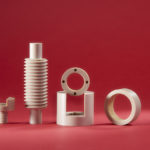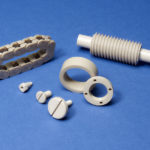Written by Barbara Gerard | CEO
Craftech Industries, Inc.

PTFE or Teflon-coated fasteners are highly corrosion resistant, especially at elevated temperatures.
PTFE is more commonly referred to as Teflon, a registered trademark of DuPont, the multinational chemical company where the material was first developed. PTFE is often fabricated into fasteners, such as screws, hex nuts, hex-head cap screws, flat washers, and others. It’s also used to fabricate custom parts. However, this material can only be turned, or made into parts on a CNC machine.
Although PTFE can be compression molded (using high pressure and heat), it cannot be injection-molded (which injects the raw material into a mold cavity). This is because it’s not thermoplastic. Thermoplastics are pliable at elevated temperatures and then solidify upon cooling.
So, what is Teflon exactly? Polytetrafluoroethylene (PTFE) is a solid fluorocarbon and synthetic fluoropolymer. The material is made wholly of carbon and fluorine atoms. It has a high molecular weight and is hydrophobic, meaning it does not absorb water.
Fasteners and custom parts made of PTFE are used in applications where high heat and chemical resistance are required. One disadvantage is that PTFE is that it’s not very strong. For instance, it’s so soft you can make an imprint in the material with a fingernail. PTFE is a deformable plastic and is not elastomeric, so it does not naturally retain shape and is subject to creep.
Discovering Teflon
PTFE or polytetrafluoroethylene was accidentally discovered in 1938. At the time, Roy J. Plunket was a chemist with the now multinational chemical company, DuPont, and he attempted to produce chlorofluoroethylene, which is a refrigerant.
Instead, he accidentally made another discovery: the inside of one bottle was coated with a waxy and extremely slippery material. Teflon became the registered trademark in 1945.
By 1948, a DuPont company, Kinetic Chemicals, partnered with General Motors. They produced more than 900 tons of Teflon® per year. The material was initially used by the military in artillery shell fuses and in the production of nuclear material for the Manhattan Project. It was also used to coat valves and seals in pipes at the uranium enrichment plant in Oak Ridge, Tennessee.
By the ’50s, scientists developed copolymers that kept most of the chemical and mechanical properties of PTFE but made it easier to mold. This opened up more practical applications for the material. One example is non-stick Teflon cookware. Another: Teflon®-coated fasteners.

PTFE is a two-coat, non-sticky fluoropolymer coating with high operating temperature and good chemical resistance.
Chemical resistance
Only a few substances can affect the carbon-fluorine bonds of PTFE, including alkali metals (molten or in solution.) Rare, fluorinated compounds at high temperatures and pressures such as xenon difluoride and cobalt (III) fluoride can also attack the bonds. Additionally, aluminum and magnesium at high temperatures will damage them.
PTFE has one of the lowest coefficients of friction of any solid. This makes it nearly impossible to glue anything to Teflon, regardless of the material or adhesive used.
Temperature
PTFE is a polymer with a melting point of 326° C or 620° F. In addition, it also maintains its properties such as high strength, toughness, and self-lubrication at extremely low temperatures, such as -268° C or -450° F. At temperatures, above 650° C or 1200° F, PTFE will undergo depolymerization.
Teflon is non-flammable. This is one advantage for fasteners and custom parts. Depending on the applications, engineers often consider Teflon a cost-effective material choice for corrosion resistance. It can be an ideal choice over weaker alloys, such as stainless steel.
Applications
Thanks to its unique advantages, PTFE is used in several applications, from cookware to aerospace and many more. The material has excellent dielectric properties. So, about 50% of PTFE production is used in wiring and components for aerospace, computer, and semiconductor applications because of this insulating property.
Another example is in industrial applications because of the material’s low friction. PTFE is fabricated into bearings, gears, gaskets, bushings, and other parts that must operate in a sliding action. This results in energy savings for the operation of some machinery.
Teflon-coated fasteners are also used in automotive engines to reduce friction or in other industrial machinery to prevent rusting or corrosion due to chemicals in the air or water.
Additional applications include medical device manufacturing, food processing plants, construction, plumbing (seals), and others.
The advantages of PTFE include:
- Corrosion resistance – resistant to organic, acid, and alkaline corrosion, with a far higher tensile strength than stainless steel
- Chemical and UV resistance – inert to a range of solvents and chemicals, including sunlight
- Non-flammable and electrically safe – excellent dielectric properties and widely used as an electrical insulator
- Hydrophobic – resists water and moisture absorption (<0.1% in 24 hours)
- Temperature stable – usable between about -350° and 500° F, with a melting point over 600°F
- Highly flexible – pliable, even at below-freezing temperatures
- Low surface friction – the material slides easily much like a lubricant
- Non-stick surface – easy to clean and resists contamination









Tell Us What You Think!